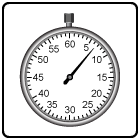


3 scores max per player; No foul language, show respect for other players, etc.
Name | Score | Date | ||
|---|---|---|---|---|
| 1 | ||||
| 2 | ||||
| 3 | ||||
| 4 | ||||
| 5 | ||||
| 6 | ||||
| 7 | ||||
| 8 | ||||
| 9 | ||||
| 10 |
This is a timed game. Your final score is equal to the total score minus time taken.
Game: CHOOSE OR LOSE
Aim: Choose the right answer; beat the clock
Method:
You start the game with 50 points. Each question has 2 to 4 answers. Select the correct answer before your time runs out to score points. Right answers are +10, wrong answers are -2, out of time is -5.
This is a timed game. Your final score is equal to the total score minus time taken.

anonymous
"Calculate the mean"
CHOOSE OR LOSE game to practice
'Metric weights: different units' for 4th grade
4th grade / Measurements / Compare: weight / Metric weights: different units
Compare weights in different metric units
To compare weights in different metric units and choose the heaviest item, you need to first convert all weights to the same unit. The most commonly used metric units for weight are grams (g) and kilograms (kg), with 1 kg equal to 1,000 g. Here's how to compare weights in different units and find the heaviest item:
- Convert all weights to the same unit: Choose a common unit, either grams or kilograms, and convert all the weights to that unit. This will make it easy to compare the weights.
For example, let's say you have three items with the following weights: 1.5 kg, 950 g, and 1,250 g. To compare these weights, convert the one in kilograms to grams: 1.5 kg x 1,000 = 1,500 g - Compare the converted weights: Now that all the weights are in the same unit (grams, in our example), you can easily compare them to determine the heaviest item. In out example, you can see that the first item has a mass of 1,500 g which is greater than 950 g or 1,250 g so it is the heaviest item.
This topic gives you the mass of 3 items in mixed decimal units. You are required to determine which is the heaviest item by converting all items to the same units and comparing them.
With our Choose or lose math game you will be practicing the topic "Metric weights: different units" from 4th grade / Measurements / Compare: weight. The math in this game consists of 12 questions that ask you to compare weights in different metric units and choose the heaviest item.

Our CHOOSE OR LOSE game is a simple activity to help elementary math learners and will improve the speed at which you can solve problems in the given topic. It does not rely on the learner typing in the answer. Rather, the learner must choose the correct answer from a list of 2, 3 or 4 similar answers.
CHOOSE OR LOSE encourages faster problem-solving for common and vital elementary math topics. CHOOSE OR LOSE is a timed game with a leaderboard for each topic at each of the 4 levels on offer. You can play the game with or without audio and robots.
UXO * Duck shoot * The frog flies * Pong * Cat and mouse * The beetle and the bee
Rock fall * Four in a row * Sow grow * Choose or lose * Mix and match

Latest leaderboard entries: Choose or lose




How to play Choose or lose to practice
'Metric weights: different units' for 4th grade

Our CHOOSE OR LOSE game asks the learner to click on the correct answer from a selection of possible answers before the clock runs down.
- Click on PLAY to start.
- You are presented with a topic question, then a list or grid of 2 to 4 possible answers (depending on the topic you have chosen).
- You must select the correct answer by clicking on it before the clock counts down.
- You have 10 seconds in total to answer each question.
- The clock starts ticking down 5 seconds after the answers have appeared.
- To hear the question again, click / tap on the question box.
- The browser will speak the potential answers on rolling-over them.
- A correct answer gains you 10 points.
- A wrong answer loses you 2 points.
- A time-out loses you 5 points.
- A score is kept of correct answers against number of answers.
- The game is timed, and your final score (points earned minus time taken) is given at the end of the game. Top 10 scores for a topic get you a place on the leaderboard.










